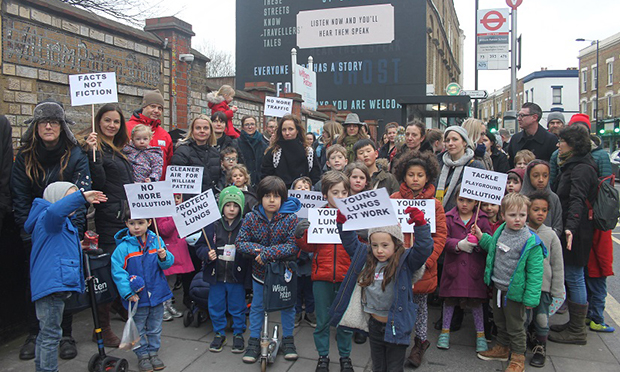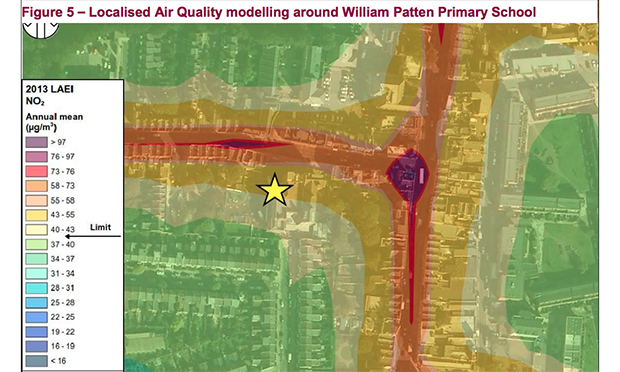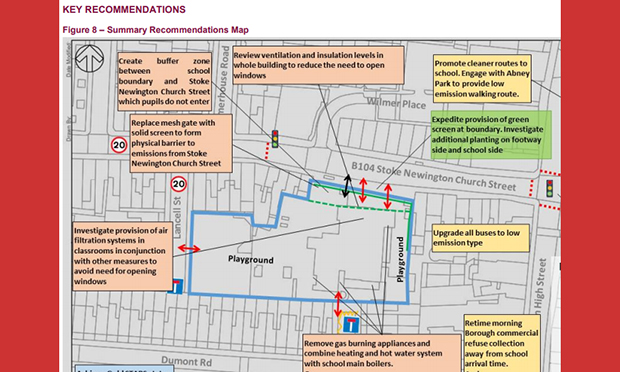Road closures: Council on ‘shaky ground’ after release of William Patten air quality report, say campaigners

Fuming: Campaigners outside William Patten Primary School. Photograph: CAWP
Campaigners have again called for the council to scrap its road closure plans in Stoke Newington after a new report by the Mayor of London’s office found that pollution levels at William Patten Primary School are already above the legal limit – so much so that it recommends closing off part of the playground.
The Greater London Authority (GLA) report follows an air quality audit of William Patten, which was found to be one of the capital’s 50 most polluted schools.
The council is carrying out extended analysis of traffic and pollution around the Church Street school before making a final decision on plans to close off a nearby cut-through.
The proposal has attracted heavy criticism from campaign group Cleaner Air for William Patten (CAWP), which says it will lead to more vehicles using Church Street.
The two sides disagree on the legality of nitrogen dioxide levels at the school, with the council accusing campaigners of applying the wrong limits at certain parts of the site.
But the GLA report appears to back CAWP’s claims that the amount of dirty air breaches National Air Quality Objectives across the entire school site.
In response, Hackney’s transport chief and newly promoted deputy mayor Cllr Feryal Demirci said the council’s own monitoring “indicates this is not true”, and she is concerned that its findings “are not reflected within the report”.

A map in the report shows pollution levels around William Patten. Image: GLA
CAWP’s Sally Newsom, whose son goes to William Patten, said: “We’re staggered Hackney Council stands behind road closure proposals that will displace extra traffic past the school when the Mayor of London’s Office considers air quality here is so bad it’s suggesting closing a section of the playground.”
Campaigners estimate that 13,700 vehicles travel within a 200-metre radius of William Patten each day, and reiterated their fears that the proposed closure of Walford, Beatty and Brighton Roads could increase that figure by up to 2,000 vehicles per day on Church Street alone.
Newsom added: “The Council is on shaky moral and legal grounds if it presses ahead with these road closures.
“William Patten is in an area that’s already over the legal limit and, for the hundreds of little children breathing dirty air, that can have very real health consequences.”

The report produced a number of recommendations to reduce toxic fumes. Image: GLA
As well as creating a no-go area for children in a section of the playground closest to Church Street, the GLA also recommends that the council reschedules its waste collections so HGVs are not using the road as kids arrive for school.
It also suggests the introduction of air filtration systems in classrooms to allow windows to be kept shut.
The report notes that buses on Church Street will eventually be replaced with a fleet of lower-emission vehicles, and that the road will also benefit if the planned expansion of London’s Ultra-Low Emission Zone (ULEZ) goes ahead.
CAWP member Tom Knowles said: “Eighteen out of Hackney’s 20 most polluted schools are on main roads – in putting forward measures that displace more traffic to those roads, the council is knowingly treating primary school children as collateral damage.
“We’re all for creating more liveable streets but not if the cost is child health. We welcome the idea of a low emission zone and, in the meantime, the council simply must not worsen an already critical situation.”

Title boost: Feryal Demirci has been made a deputy mayor. Photograph: Hackney Council
Cllr Demirci said: “We have been monitoring air quality at William Patten School for some time as part of our project to determine whether schools across the borough meet national air quality objectives.
“We will meet the school again in June, once we have produced air quality models of the current position, and to go through any recommendations.
“Our advice will take into account the GLA’s report, but will not necessarily endorse all of the recommendations – for example the recommendations indicate that a filtration system is likely to be of low effectiveness.”
The GLA report says filtration systems are “high cost, only cover a single room per unit, and do require ongoing maintenance and power consumption”, but that they have “demonstrated some encouraging initial scientific evidence of efficiency”, with some claims that they can “eliminate 99.5 per cent of NO2”.
The council says it needs to fully review the report and meet school bosses before deciding which of its recommendations to implement.
On the monitoring figures, Cllr Demirci added: “The GLA’s report suggests that the entire school site exceeds the annual mean objective for nitrogen dioxide, but our monitoring indicates this is not true.
“We made the GLA aware of our initial findings and are concerned that they aren’t reflected within the report.”
You can read the GLA’s report in full here
